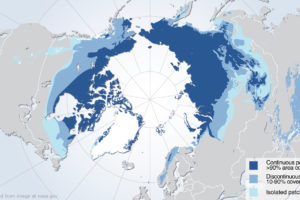Who Will Pay For Russia’s Unprecedented Oil Spill?

(Oilprice.com – Alex Kimani – June 11, 2020)
Five days ago, Russia suffered its worst oil spill in modern history after a fuel storage tank owned by Russian nickel and palladium mining company, Nornickel, collapsed and spilled 21,000 tonnes (about 158,000 barrels) of diesel into the nearby Ambarnaya river outside the Siberian city of Norilsk. The accident–which has drawn comparisons to the Exxon Valdez accident off Alaska in 1989– is being regarded as the worst of its kind in Russia’s Arctic region. One source has reported that as much as 29,000 tonnes (about 218,000 barrels) of diesel could have found its way into the soil and nearby water bodies.
President Vladimir Putin declared a state of federal emergency in the Krasnoyarsk region as Nornickel scrambled to try and contain the spill from contaminating the Arctic zone. But their best efforts have failed, and now there are reports that the oil has flowed 12 miles north and seeped into a nearby Arctic Lake where it might cause untold damage to marine ecosystems.
Putin is reportedly incensed that the incident was only reported to the authorities two days after pictures of the crimson river surfaced online, and has told Nornickel’ billionaire oligarch and part-owner, Vladimir Potanin, to bear the full costs of cleaning up the mess.
More interestingly, it has brought Russia’s rather ambivalent attitude towards climate change and global warming to the fore once again as Russia’s authorities and Nornickel continue to play the blame game.
Russia’s Ambivalence
On the one hand, Nornickel has blamed melting permafrost in what it has termed as “anomalously warm temperatures” for the collapsed tank that has served accident-free for three decades.
But Russian authorities are having none of it.
The Investigative Committee charged with the task of probing the accident has laid the blame squarely on negligent maintenance crew by Nornickel, saying it failed to carry out major repairs on the tank in 2018 and instead “… continued to use it in breach of safety rules”.
Alexey Knizhnikov of the World Wildlife Federation (WWF) has also dismissed Nornickel’s remarks calling them “..an attempt to write off Nornickel’s failure in risk management and ecological safety on the fashionable topic of climate change. The main factor is mismanagement.”
It’s easy to dismiss Nornickel’s defense merely as a case of shifting the blame considering that it could be facing up to $4 billion in cleanup costs including fines, comparable to the $4.3 billion that Exxon spent cleaning up the 37,000 tonnes (260,000 bbl) of crude that in Alaska from a ship carrying 1,260,000 bbl. The Exxon accident is regarded as the second-largest in U.S. waters after the 2010 Deepwater Horizon Oil Spill by BP that released 140,000 bbl of crude into the Gulf of Mexico.
While it’s currently difficult to absolve Nornickel from blame for failing to fix its aging infrastructure, it’s also fair to acknowledge that the company lies in the epicenter of a region that is feeling the full brunt of climate change and global warming.
It’s a well-established fact that Russia is warming 2.5x faster than the planet as a whole. BBC Weather has reported that temperatures within the Arctic Circle climbed to an “astonishing 30C” this week, a highly unusual occurrence for a region that has remained permanently frozen at 32°F (0°C) or colder for decades. A large number of industries, roads, and entire cities are built atop the permafrost terrain in Russia. When the permafrost thaws, the ice that has remained stable and buried deep in the ground loses stability. Experts have already noted that thawing permafrost is responsible for fissures that have appeared in apartment buildings in Norilsk.
Environmental groups such as the World Wildlife Fund and Greenpeace Russia have pointed out that the risks of thawing permafrost to Arctic infrastructure are public knowledge, and companies like Nornickel should take the necessary steps to avert disasters.
Russia has an interesting stance on climate change. Just like Trump has in the past accused climate change scientists of having a political agenda, saying he remains unconvinced that humans are responsible for the earth’s rising temperatures, Putin also believes in global warming but denies that actions by humans are to blame. Russia could even be accused of trivializing the matter after the Kremlin recently published a document outlining the possible “positive” effects of global warming, including expanding agricultural areas, decreasing energy use in cold regions, and navigational opportunities in the Arctic Ocean.
Perhaps this kind of attitude is to be expected, with both countries being some of the world’s biggest oil-producing regions.
Cost of Climate Change
Last year, the Carbon Disclosure Project (CDP) warned that global warming could cost the global economy $1 trillion dollars over the next five years through crumbling infrastructure, damage to the environment, including wildfires and storms, reduced crop yields, and health problems.
With nearly 65% of Russia covered in permafrost, the country’s mitigation plans, including dam-building or switching to more drought-resistant crops, are going to be severely tested in the coming years.
Still, Russia remains ahead of the United States in the race to beat climate change after Moscow formally adopted the Paris Climate Accord and criticized Washington’s withdrawal from the pact.
[article also appeared at oilprice.com/Energy/Energy-General/Who-Will-Pay-For-Russias-Unprecedented-Oil-Spill.html]
[featured image above is file image from an earlier year]
